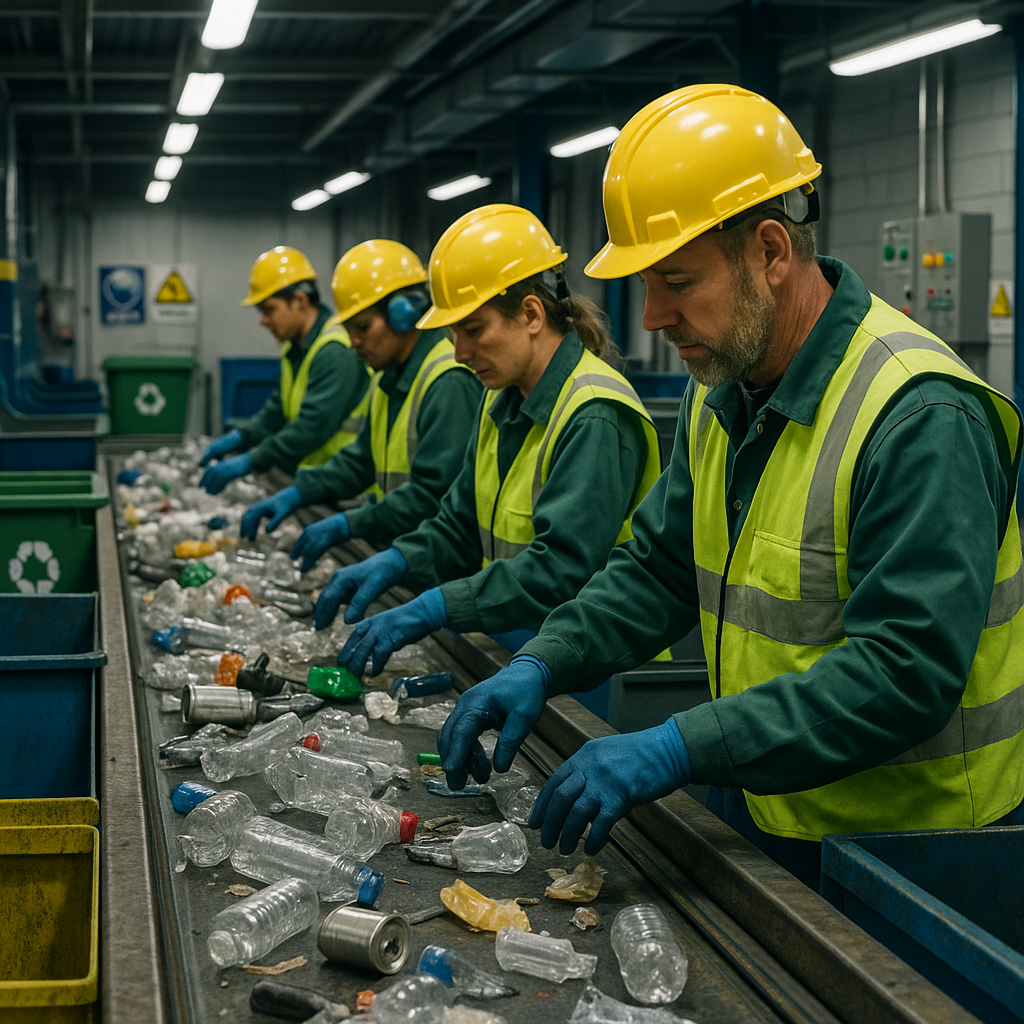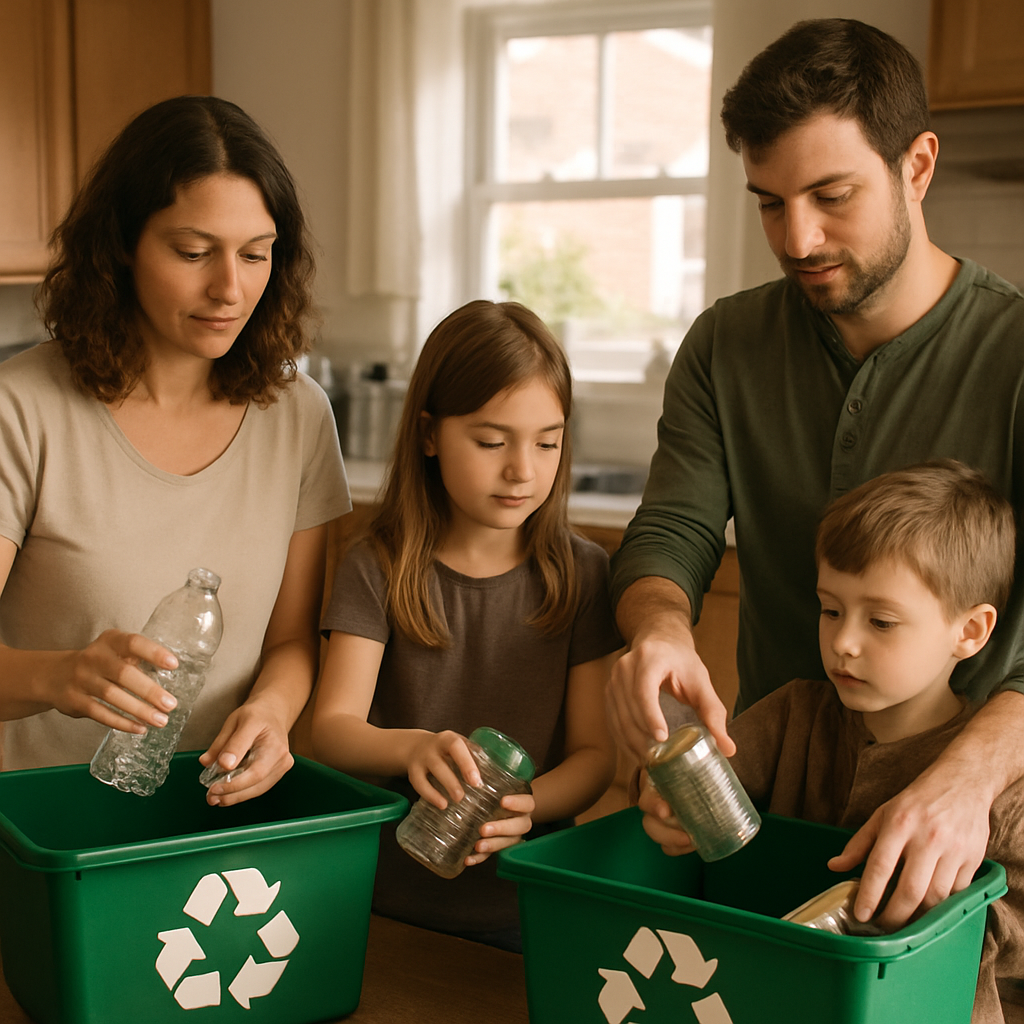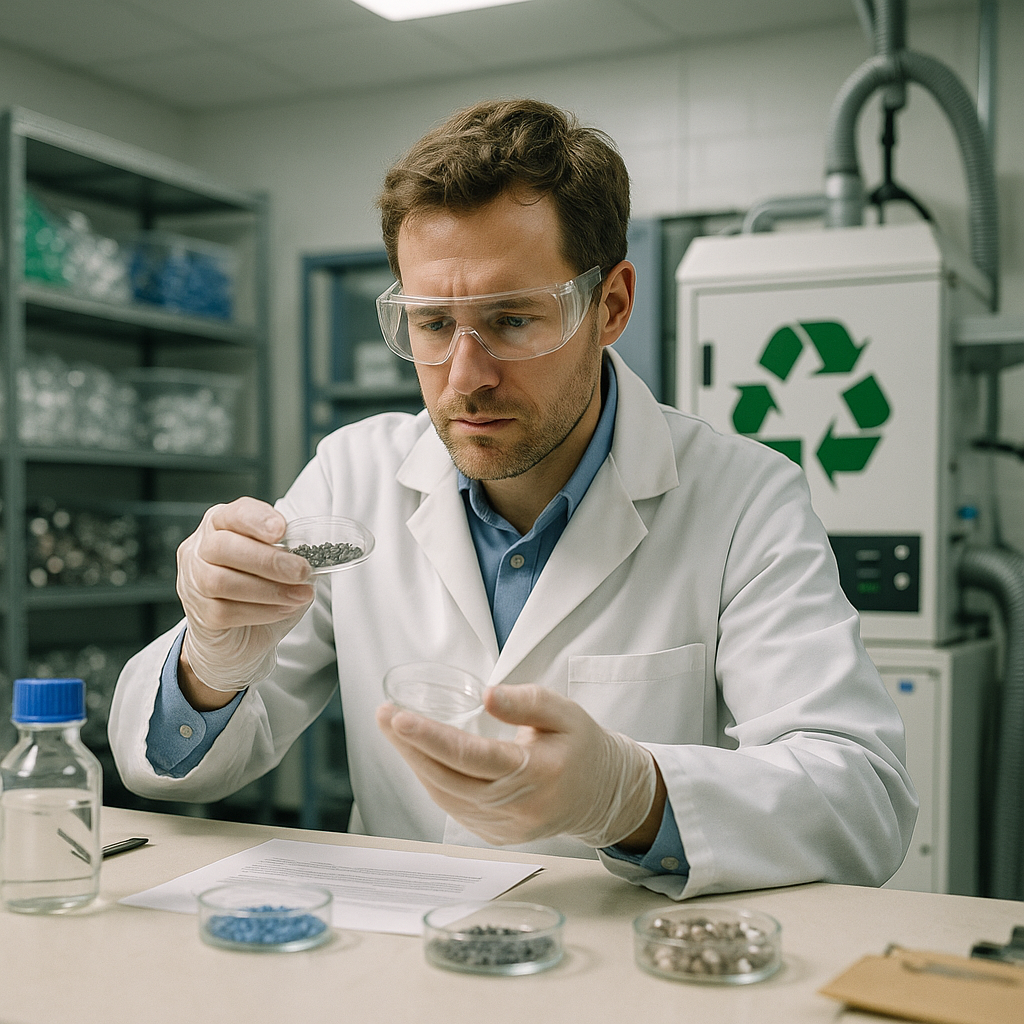5901 Botham Jean Blvd, Dallas, TX 75215
Understanding Recycling: What is Plastic and Metal Recycling?
August 26, 2025Plastic and metal recycling transforms discarded materials into valuable resources for manufacturing new products. This essential process begins with collection, followed by careful sorting and processing, giving these materials a second life. Every aluminum can or plastic bottle recycled represents a small but significant victory for our environment.
The recycling journey starts when we dispose of items in designated bins rather than trash cans. These materials are then transported to specialized facilities where they undergo thorough sorting based on type and composition. Modern recycling centers use advanced technologies to efficiently separate different materials, ensuring higher quality recycled output.
Both environmental and economic benefits make recycling a crucial sustainability practice. By diverting waste from landfills, recycling conserves natural resources, reduces energy consumption, and decreases greenhouse gas emissions. The numbers speak for themselves—recycling one ton of plastic saves approximately 130 million kilojoules of energy, while recycling aluminum uses 95% less energy than producing it from raw materials.
How Does the Recycling Process Work?

The recycling journey begins at your curb and involves several key stages before materials become new products. This process helps divert billions of pounds of waste from landfills each year while conserving valuable resources.
Collection: The Journey Begins
Placing items in your recycling bin initiates a complex reverse supply chain. Haulers collect these materials from residential and commercial properties and transport them to specialized facilities for processing.
Collection trucks have evolved significantly in recent years. Many modern vehicles can compact materials during collection, improving transportation efficiency and reducing carbon emissions.
Material Recovery Facilities: The Sorting Hub
At Material Recovery Facilities (MRFs), the real transformation begins. These industrial plants use a combination of manual labor and sophisticated technology to sort mixed recyclables into specific categories.
The sorting process typically follows these steps:
- Initial tipping: Collection trucks dump materials onto the tipping floor, where large pieces of contamination are removed.
- Pre-sorting: Workers manually remove non-recyclable items, hazardous materials, and other contaminants from the conveyor belt.
- Mechanical sorting: Materials travel through a series of screens, magnets, and optical sorters that separate them by size, shape, and material type.
- Paper separation: Large rotating discs help separate flat paper and cardboard from containers.
- Magnetic separation: Powerful magnets extract steel and tin cans from the stream.
- Eddy current separation: This technology uses magnetic fields to separate aluminum from other materials.
- Optical sorting: Advanced sensors and air jets identify and separate different types of plastics.
- Quality control: Final manual inspection ensures proper separation before baling.
Processing: From Waste to Raw Material
Once sorted, materials are compressed into dense bales and sold to specialized recyclers. These recyclers transform the materials through various processes:
For plastics, processing typically involves:
- Grinding into small flakes
- Washing to remove labels, adhesives, and contaminants
- Separating different plastic types through float-sink tanks
- Melting and filtering out impurities
- Forming into pellets that become the raw material for new products
Metals undergo smelting, while paper is pulped, cleaned, and reformed into new paper products. Glass is crushed, melted, and molded into new containers.
Manufacturing: Completing the Loop
The final stage involves manufacturers purchasing these processed materials to create new products. Using recycled materials instead of virgin resources generally requires significantly less energy. For example, creating aluminum from recycled materials uses about 95% less energy than extracting it from bauxite ore.
Companies across various industries incorporate recycled content into their products. From beverage containers to construction materials and textiles, recycled materials increasingly form the backbone of sustainable manufacturing.
The Impact of Proper Recycling
The success of this entire system depends on proper sorting at the source. When non-recyclable items end up in recycling bins, they can damage equipment, create safety hazards for workers, and contaminate otherwise recyclable materials.
By understanding how the recycling process works, consumers can make more informed decisions about what belongs in their recycling bins. Clean, properly sorted recyclables lead to more efficient processing and higher-quality recycled materials.
What Are the Environmental Benefits of Recycling?
Recycling plastic and metal offers substantial environmental advantages by changing how we use and reuse materials. Instead of extracting new resources, recycling keeps valuable materials in circulation. This circular approach transforms waste management from a linear process into a sustainable cycle with extensive ecological benefits.
The conservation of natural resources is a primary benefit of recycling programs. By processing used plastics and metals instead of mining virgin materials, we significantly reduce environmental disruption. For example, aluminum recycling eliminates the need for bauxite ore extraction, which often causes habitat destruction, soil erosion, and water contamination. Similarly, recycling steel conserves iron ore, coal, and limestone, protecting natural landscapes from mining operations.
Energy conservation is another crucial advantage of recycling initiatives. Manufacturing products from recycled materials requires much less energy than processing raw materials. Aluminum recycling saves approximately 95% of the energy needed to produce new aluminum from bauxite ore. Steel recycling achieves energy savings between 60-74%, while plastic recycling can reduce energy consumption by 70-88%, depending on the type.
These energy savings lead directly to reduced greenhouse gas emissions. When manufacturers use recycled materials, they bypass energy-intensive extraction and processing stages. For instance, recycling one ton of aluminum prevents about 9 tons of CO2 emissions. Similarly, steel recycling results in an 86% reduction in air pollution compared to traditional manufacturing methods.
Recycling also plays a crucial role in pollution prevention and ecosystem protection. By diverting materials from landfills, recycling programs reduce the volume of waste potentially contaminating soil and water. Plastics, in particular, pose serious environmental threats when improperly disposed of, as they take hundreds of years to decompose while releasing harmful chemicals. Recycling these materials keeps them out of oceans and waterways, where they endanger marine life and disrupt fragile ecosystems.
Water conservation is another benefit of recycling practices. Manufacturing with recycled materials typically requires significantly less water than processing virgin resources. For example, steel production using scrap instead of virgin ore uses approximately 40% less water and generates 97% less mining waste, protecting valuable water resources.
The collective impact of these benefits creates a compelling environmental case for recycling. By conserving resources, saving energy, reducing emissions, and preventing pollution, recycling programs contribute significantly to environmental sustainability while providing economic advantages through reduced production costs.
What Can Individuals Do to Support Recycling Efforts?

Effective recycling starts with individual action. Through proper sorting, preventing contamination, and making mindful purchasing decisions, each person can significantly impact waste diversion rates. Simple daily habits create a foundation for sustainable waste management.
Follow Local Recycling Guidelines
Recycling requirements vary widely between locations. What is recyclable in one city might not be in another. Contact your local waste management authority or visit their website to get specific information about what materials they accept.
Many municipalities provide detailed recycling guides showing exactly which items belong in recycling bins. Keep these guides visible near your recycling area for quick reference. Staying informed about local guidelines prevents contamination that could send entire batches of recyclables to landfills.
Practice Proper Sorting and Preparation
Correct sorting forms the foundation of effective recycling. Separate different materials according to local requirements. Most programs accept paper, cardboard, certain plastics, glass, and metal cans.
Clean your recyclables before disposal. Rinse food containers to remove residue, but don’t worry about making them spotless. “Spatula-clean” is sufficient for most recycling programs. Remove non-recyclable components like plastic windows from envelopes or plastic caps from glass bottles when required.
Flatten cardboard boxes to save space and make collection more efficient. Keep paper dry and free from food contamination. When in doubt about an item’s recyclability, check with your local facility instead of placing it in the recycling bin.
Prevent Contamination
Contamination remains one of the biggest challenges in recycling systems. Just one contaminated item can ruin an entire batch of recyclables. Common contaminants include food waste, plastic bags, styrofoam, and non-recyclable plastics.
Never place plastic bags in regular recycling bins. Instead, return them to grocery stores that offer plastic bag recycling programs. Keep hazardous waste like batteries, electronics, and paint out of standard recycling streams. These items require special handling through designated collection sites.
Avoid “wishcycling”—the practice of tossing questionable items into recycling bins in the hope they’ll be recycled. This well-intentioned habit actually creates problems in the recycling process and can cause entire loads to be rejected.
| Household Item | Recyclability |
|---|---|
| Aluminum Cans | Recyclable |
| Plastic Bottles | Recyclable (Rinse before recycling) |
| Glass Bottles and Jars | Recyclable |
| Paper | Recyclable |
| Cardboard | Recyclable (Flatten before recycling) |
| Plastic Bags | Recyclable at specific drop-off points |
| Batteries | Recyclable at specialized locations |
| Old Electronics | Recyclable at electronics recycling centers |
| Clothing and Shoes | Recyclable through specific programs |
| Crayons | Recyclable through the National Crayon Recycling Program |
| Tires | Recyclable through tire collection programs |
| Household Hazardous Waste | Recyclable at hazardous waste facilities |
Create Efficient Home Recycling Systems
Set up a convenient recycling station in your home with clearly labeled bins. Place recycling containers in high-traffic areas where waste is commonly generated, such as the kitchen, home office, and bathrooms.
For limited spaces, consider under-sink organizers or over-the-door racks to maximize vertical space. Establish a regular schedule for emptying indoor bins and taking materials to curbside collection points or recycling centers.
Involve all household members in recycling efforts. Create simple visual guides near your recycling station to remind family members of proper sorting techniques. Assign recycling responsibilities on a rotating basis to distribute the workload and build sustainable habits.
Support the Recycling Market
Creating demand for recycled products completes the recycling loop. Look for products made with recycled content when shopping. Many items, from paper products to clothing and furniture, now incorporate recycled materials.
Check packaging labels for phrases like “made from post-consumer content” or “contains recycled materials.” Purchasing these products sends a market signal that encourages manufacturers to use more recycled materials in their production processes.
Consider buying in bulk to reduce packaging waste. Choose products with minimal packaging or packaging that can be easily recycled in your area. These purchasing decisions directly support the economic viability of recycling systems.
Beyond Recycling: Reduce and Reuse
Remember that recycling is just one part of sustainable waste management. Whenever possible, reduce consumption first. Opt for reusable alternatives to single-use items like water bottles, shopping bags, and food containers.
Before recycling an item, consider if it can be repurposed or donated. Extending a product’s useful life through reuse conserves even more resources than recycling. Create an “upcycle station” where gently used items can be repurposed or donated instead of discarded.
Composting organic waste diverts material from landfills and creates valuable soil amendments. Set up a home composting system for food scraps and yard waste if space allows, or look for community composting programs in your area.
Conclusion: The Future of Plastic and Metal Recycling

As sustainability concerns grow worldwide, plastic and metal recycling has become a vital strategy in our efforts to combat environmental degradation. Although global recycling rates are currently low—with plastic recycling at just 9% compared to metals like aluminum at 76%—there is potential for improvement through technological innovation and policy development.
The future of effective recycling depends on several key factors. Technological advancements, including AI-driven sorting systems, blockchain for supply chain transparency, and chemical recycling methods, offer new opportunities for processing materials that were previously challenging to recycle. Economic incentives such as deposit-refund schemes, extended producer responsibility programs, and taxes on virgin materials have proven successful in various countries. Combined, these approaches can help balance the rising production of plastics with our ability to recycle them in a sustainable manner.
For your recycling needs, contact Okon Recycling at 214-717-4083. Our expertise in managing various recyclable materials enables us to support your efforts in this crucial environmental initiative.
